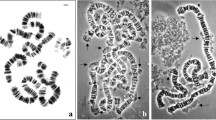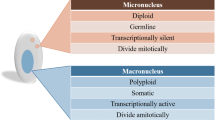Abstract
After sexual reproduction in ciliates, the old macronucleus degenerates and a new macronucleus is formed from a micronuclear derivative. Macronuclear development in hypotrichous ciliates includes the formation of polytene chromosomes, degradation of these chromosomes and elimination of DNA, specific fragmentation of macronuclear DNA in short gene-sized DNA molecules and specific amplification of these molecules. After fusion of the two haplid micronuclei, the zygote nucleus divides mitotically; one of the daughter nuclei develops into a new micronucleus and the other into a new macronucleus. A first DNA synthesis phase in the developing macronucleus (macronuclear anlage) leads to the formation of polytene chromosomes. These polytene chromosomes become degraded and up to over 90% of the DNA is eliminated, leading to a DNA-poor stage. During a second DNA synthesis phase, replication bands become visible, and finally the new vegetative macronucleus is formed (for a review see Ammermann et al. 1974, Prescott 1994, Lipps & Eder 1996). As in most other ciliates analysed so far (for a review see Prescott 1994), rDNA occurs as a single-copy gene in the micronucleus but is highly amplified in the vegetative macronucleus (Steinbrück 1990). This amplification of rDNA is accompanied by the formation of many new nucleoli in the course of macronuclear development. In the light microscope, nucleoli become first visible at the beginning of the second DNA synthesis phase and multiply in subsequent rounds of replication (Ammermann et al. 1974). In this report, we describe the amplification of rDNA and the formation of new nucleoli during macronuclear differentiation by in situ hybridization of rDNA to different stages of the developing macronucleus.
Similar content being viewed by others
References
Ammermann D, Steinbrück G, v.Berger L, Hennig W (1974) The development of the macronucleus in the ciliated protozoan Stylonychia mytilus. Chromosoma 45: 401–429.
Feinberg AP, Vogelstein B (1983) A technique for radiolabeling DNA restriction endonuclease fragments to high specific activity. Anal Biochem 132: 6–13.
Lipps HJ, Eder C (1996) Macronucleus structure and macronucleus development in hypotrichous ciliates. Int J Dev Biol 40: 141–147.
Prescott DM (1994) The DNA of ciliated protozoa. Microbiol Rev 58: 233–267.
Olins DE, Olins AL (1994) The replication band of ciliated protozoa. In Rev Cyt 153: 137–170.
Raap AK, van der Rijke FM, Dirks RW, Sol CJ, Boom R, van der Ploeg M (1991) Bicolor fluorescence in situ hybridization to intron and exon mRNA sequences. Exp Cell Res 197: 319–322.
Steinbrück G (1990) Recent advances in the study of ciliate genes. Eur J Protistol 26: 2–14.
Author information
Authors and Affiliations
Corresponding author
Rights and permissions
About this article
Cite this article
Maercker, C., Harjes, P., Neben, M. et al. The Formation of New Nucleoli During Macronuclear Development of the Hypotrichous Ciliate Stylonychia lemnae Visualized by in situ Hybridization. Chromosome Res 5, 333–335 (1997). https://doi.org/10.1023/B:CHRO.0000038764.83094.aa
Issue Date:
DOI: https://doi.org/10.1023/B:CHRO.0000038764.83094.aa




